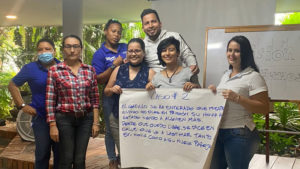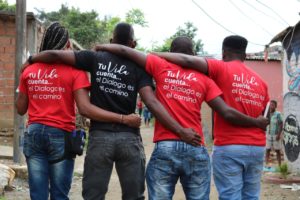In a world full of violent cities, Cali is a uniquely difficult place. A city of 2.4 million people, Cali has more than 1,200 killings a year and has consistently been atop the annual lists of most violent cities in the world. Cali is known as a central city for the international drug cartels, and it has a culture of open involvement in the drug trade. It is estimated that half of the cities residence live in areas of high violence, some in semi-autonomous settlements.
In the summer of 2021, protests broke out across the city inspired by the lack of opportunity and the high violence. Businesses ground to a halt; people could not get to their workplaces; exports could not get to port; imports could not get to the ports or off the docks. Many of the large businesses and industries of Cali got together and decided that they needed to help find solutions for the people of the city, including for urgently addressing the violence. The business specifically realized that the city may not be viable as a city with violence rates as high as they are.
Cure Violence began in Cali in 2017 in two of the most violent communities – Charco Azul and Comuneros. An evaluation of the first two years of the pilot found reductions in killings due to the program of 47% and 30% respectively. This success helped to pave the way for expansion.
 Citywide Approach
Citywide Approach
In 2021 and 2022, with funding from the businesses of Cali, over 100 violence interrupters have been hired to cover 50 areas of the city. The Cali Cure Violence program includes 400 volunteer interrupters that create a network of support for each violence interrupter comprised of credible member of the community. These volunteers are the eyes and ears of the lead interrupter, helping to identify conflicts and work out the methods to stop it from becoming violent.
The citywide approach also includes support from Mayor’s office, which has given opportunities specifically to participants in the Cure Violence program, such as summer jobs and educational opportunities.

Outreach workers in Cali Colombia
Cali is the only Cure Violence adaptation in Latin America to include outreach work with caseloads or participants, a role played by hybrid violence interrupters who work to mediate conflicts and change behavior at the same time. In other areas of Latin America, due to the nature of the violence and the lack of sufficient resources, Cure Violence programs are limited to only violence interruption.
The approach is considered by the Cure Violence Latin America team to be the realization of a more complete implementation of the Cure Violence approach – well staffed sites, enhanced opportunities for participants, and involvement of the community in helping to interrupt the spread of violence and changing norms.
Impact
The city is beginning to see the impact, with large reductions in many areas. There are many examples of people who were involved in the drug trade, fights, gangs, robbery — and they have changed. Some go into trade school, others finish high school, and so many other paths out of the violence.
There are likewise many examples of interruptions. Last week in Charco Azul, one of the most violent neighborhoods in Cali, a man told an interrupter that he intended to kill a man. “I’m not letting this go – I’m going to kill him,” he said. The interrupter told him, “Hang on, let’s sit down and have a drink.” The interrupter was thinking that if he kept talking and was able to keep him where they were, he could stop the killing. The two stayed up all night until the man fell asleep. By the next morning, he had cooled down.
While one approach is just one piece of what is needed, the success of the Cure Violence approach in one of the most violent cities in the world provides a vision for other cities atop the world’s most violent cities list. If you can reduce violence in Cali, you can do it anywhere.


